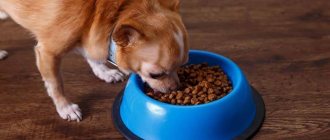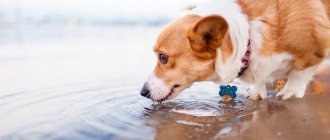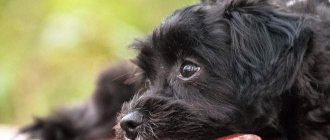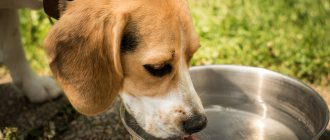In this article I will talk about the reasons why dogs refuse to drink and eat. I will describe the dangers associated with insufficient food and fluid intake, the reasons why you don’t drink water, and what to do even if your nose is cold. Why is the dog lethargic and lying down, no appetite, constantly sad and how to treat it. Let me explain when it is necessary to contact a veterinarian. I will give the norms for water consumption and how much to drink for the animal.
Water is a chemical element necessary and indispensable for the health and functioning of a living organism. Participates in all life processes: structure, development, metabolism, removal of toxins, etc.
Reasons why the dog began to refuse food and water
There are many reasons why an animal may suddenly stop drinking and eating.
For example:
- diseases of the oral cavity, manifested by inflammatory processes that are accompanied by pain (laryngitis, stomatitis, mucosal injuries);
- pharyngeal spasms, a violation of the physiology of the swallowing process, are associated with a number of viral and autoimmune diseases;
- general diseases of the body (can get sick: kidney failure, diabetes, cancer), will not get up and not drink;
- dyspnea;
- overheating of the body, lethargy;
- diseases of the gastrointestinal tract (inflammatory processes, obstruction, diarrhea, constipation);
- parasitic infestations;
- poisoning of the body (severe intoxication);
- acute course of the disease associated with a high rise in body temperature, severe weakness of the body;
- obstruction of the esophagus caused by stuck foreign objects;
- small or advanced (old) age of the dog;
- dirty, musty water in a bowl, smelling unpleasant;
- inconvenient location of the bowl (high or low);
- poor quality of drinking and food utensils that emit unpleasant chemical odors, then he neither eats nor drinks anything.
If a dog does not drink enough or does not drink at all, then its body becomes dehydrated.
Please note that small dogs, particularly puppies, are more fragile and more susceptible to environmental influences.
The immunity of small dogs is weaker than that of adults and large dogs, and interruptions in health and well-being occur more often.
Lack of water and nutrients in the body has the most profound effect.
The main causes of a wet nose
There has long been an opinion that a wet and cold nose indicates good health and excellent well-being of a pet. However, this judgment is only partially correct. There are several reasons why dogs have a wet and cold nose. Let's take a closer look at each of them.
First reason
It's no secret that a dog's sense of smell is thousands of times stronger and better than that of a human. Special glands that cover the dog's nose produce a thin layer of mucus that helps capture the slightest odors, and also acts as a kind of magnet to attract substance molecules - and this significantly improves sensitivity to odors and enhances the sense of smell.
Did you know? The distant ancestors of domestic pets, which are wild dogs and wolves, with the help of their strong sense of smell were able to quickly find prey, which allowed them to survive even in the harshest conditions.
The second reason
The most obvious and simple explanation for why your pet has a wet nose is because he is constantly licking it frequently. In fact, this is done solely for hygienic purposes. Your pet understands perfectly well that after a walk or eating, his nose will definitely get dirty or clogged with dirt, which will significantly impair his sense of smell, and since the nose is the animal’s main tool for orientation in space, he licks it thoroughly and keeps it clean.
Moreover, dogs lick their nose to clear it of old mucus, which in any case has accumulated shades of “old” odors.
Third reason
Many owners know that dogs can regulate their body temperature by sticking out their tongues and breathing with their mouths open. This feature of the animal allows it not to sweat. However, every dog sweats quite a lot on its paw pads and, surprisingly, its nose. This is the third reason why your pet's nose is constantly wet. That is, a wet nose also serves as a heat exchange tool created by nature itself.
The nose helps the animal cool down when it is too hot, or, conversely, it becomes dry when the dog is cold . Thus, it becomes clear that a dog's health has nothing to do with a wet nose. Some scientists put forward the version that a dog’s thermoregulation is carried out through the nose, and not through the mouth, as was previously believed.
Fourth reason
Most often, the animal involuntarily wets its nose when eating or drinking water. Surely, while walking with your pet, you noticed that the dog sniffs damp grass - here is your answer to how moisture gets on the nose. Of course, this is far from the main reason, but only one of the additional versions.
Fifth reason
Some breeds of pets have the wettest, coldest noses due to the characteristics of their respiratory system, as well as other properties that apply only to a certain breed of animal. For example, service dogs of search breeds have a nose that is especially abundant and highly moisturized.
This is explained by the fact that service breeds were formed according to the principle of selecting animals that have the most subtle and strong sense of smell. Representatives of other breeds, in which the sense of smell does not occupy a leading position in the list of advantages, have no less wet and cold noses, for example, dogs of decorative or fighting breeds.
Fluid intake norms for an animal
The daily water intake for a dog depends on its weight, physical activity and time of year.
With a fairly active lifestyle in normal, not hot weather, 1 kg of dog’s body weight should include 20-70 ml of clean water per day.
In cases where the dog is undergoing intense training, is in a hot climate, or is ill with an increase in body temperature, the volume of fluid should be increased two to three times.
The daily water intake does not include liquid food and other drinks other than clean drinking water.
The animal needs to drink a certain amount of fluid every day
Even more facts about the dog's nose
- Some dog breeds have 220 million olfactory receptors (or more!). For comparison, people have only 5 million.
- A dog's sense of smell is approximately 100,000 times better than a human's.
- Dogs can detect objects up to 10 m underground by smell.
- While the human brain is about ten times larger than a dog's brain, the part of the brain responsible for smell is forty times larger in dogs. In fact, about 1/3 of a dog's brain mass is used to process smells (compared to 5% in humans).
- The dogs were able to sniff out bed bugs, explosives, cancer and more.
- A longer muzzle has more scent glands, allowing dogs with long muzzles to have a better sense of smell.
Dangers of not eating and drinking
Exhaustion and dehydration are conditions that are dangerous to the health and life of animals.
They affect the body as follows:
If the reason is related to health, then you need to show the dog to a veterinarian as soon as possible.
What a Dog's Nose Can Tell You About Their Health
Although dogs' noses are usually cold and wet, a change in the condition of their nose does not necessarily mean that something is wrong. Fluctuations in the temperature or humidity of a dog's nose are completely normal.
© shutterstock
Therefore, it is not the best indicator of a dog's overall health. “Dogs may have wet noses because they are healthy, and they may make wet sounds when they have a nasal condition. It's just not a reliable sign,” said Dr. Stephen Marks.
Instead, changes in behavior can give you more information about your dog's overall health.
Signs of exhaustion and illness
In order to solve the problem of a dog refusing to eat and drink, it is necessary to establish the cause.
To begin with, it is advisable to try to do this yourself. First of all, check the quality of the water in the bowl and the material of the container from which the dog drinks. Drinks for your dog should always be fresh, purified and at room temperature. It is advisable to use ceramic dishes. Rinse thoroughly after washing with cleaning products.
If this is not the reason and there are symptoms of the dog’s poor health, illness, exhaustion, you should contact a veterinary clinic for advice. An experienced specialist will be able to correctly diagnose the disease and prescribe treatment for the dog. In the hospital, the pet will be given a drip with glucose and saline, which will significantly improve the situation and give the animal strength.
Dehydration of the body leads to disruption of all organ systems, accumulation of toxins and other serious consequences.
You cannot put off solving such a problem and let the situation take its course.
The body can become exhausted and poisoning, dehydration and a general deterioration in well-being can result in vomiting when forcibly dehydrated. Which in turn will only worsen the situation. Therefore, you should not pour water into it against the will of the dog.
When dehydrated, a dog loses its appetite, becomes lethargic, and has sunken eyes.
Video: why does a dog have a wet nose?
After watching this video, you will hear about interesting versions and reasons for your pet’s wet and cold nose.
Discussions about new causes of wet and cold noses in dogs continue among scientists to this day. However, the main thing is clear - this phenomenon is not a cause for concern. But if your pet has a dry nose, then under no circumstances ignore this factor and begin to solve this problem. If you know additional information regarding the topic discussed today, then share it in the comments.
Discharge from the ear, or otorrhea
Allergy
Fungus
18168 June 24
IMPORTANT!
The information in this section cannot be used for self-diagnosis and self-treatment.
In case of pain or other exacerbation of the disease, diagnostic tests should be prescribed only by the attending physician. To make a diagnosis and properly prescribe treatment, you should contact your doctor. Discharge from the ear: causes of occurrence, what diseases cause it, diagnosis and treatment methods.
Definition
Earwax is a physiological secretion from the ear canal and protects the hearing aid from pathogenic bacteria. It contains lard, fatty acids and fat-like substances, as well as various mineral salts. Normally, a person produces 15–20 mg of earwax per month, which has the appearance of a sticky yellow-brown mass. All other discharges are considered pathological and indicate ear diseases.
Types of ear discharge
The discharge may be clear, white, light or dark yellow, or greenish (if there is pus). If blood enters the ear secretion, the discharge becomes reddish or brownish in color.
The consistency of the discharge may be watery, have a cheesy or flaky texture, and sometimes crusting may form.
An unpleasant smell of discharge due to the presence of pus in it can serve as a diagnostic sign.
What diseases and conditions cause discharge from the ear ? Wax plugs
. Excessive work of the sulfur glands leads to the formation of sulfur plug. Most often, this problem occurs in patients with diabetes mellitus, metabolic syndrome, and high cholesterol levels in the blood. The formation of cerumen plugs is provoked by increased viscosity of sulfur, dry skin, the entry of small foreign particles into the ear (for example, industrial dust), as well as excessive hair growth in the ear canal. Often, wax plugs are observed in people involved in water sports, using hearing aids, and miniature headphones.
With improper hygiene measures and independent attempts to remove excess earwax, there is a risk of pushing it deeper into the ear canal, thereby causing the formation of a plug.
Clinical signs of cerumen plug are pain and congestion in the ear, tinnitus, especially painful when the cerumen comes into contact with the eardrum, sometimes headache, dizziness, and nausea.
Mucopurulent and purulent discharge is a symptom of inflammation of the outer and middle ear. For inflammation of the outer ear (otitis externa)
the pathological process can develop in the auricle and external auditory canal (up to the eardrum). Most often, otitis externa occurs due to infection of the ear by bacteria and microscopic fungi. Its first signs are, as a rule, pain in the ear, itching, and, less often, hearing loss and a feeling of fullness. Mucopurulent discharge appears only with a widespread form of the inflammatory process throughout the entire ear canal.
The source of purulent discharge in the outer ear can also be a boil
located in the concha or ear canal.
With otitis media of the middle ear
, mucopurulent and purulent discharge becomes the result of infection of the sterile effusion from the inflamed tissues of the ear. Since the chamber of the middle ear is closed by the eardrum, purulent discharge can appear in the outer ear only after a hole has formed in it. This is preceded by severe pain in the ear, fever, decreased hearing, and in children - overexcitement, sometimes vomiting.
For mastoiditis
(inflammatory lesion of the mastoid process of the temporal bone), purulent discharge from the ear also appears. As a rule, this disease develops as a complication of otitis media and is accompanied by fever, pain and swelling in the mastoid area behind the ear.
Transparent bloody or purulent discharge appears with acute infectious myringitis
(inflammation of the eardrum), which may be of fungal or bacterial origin. Blisters filled with blood form on the surface of the eardrum, which then burst. In addition to the discharge, ear congestion is observed.
Transparent, colorless or slightly pinkish discharge from the ear can be a consequence of liquorrhea - the leakage of cerebrospinal fluid. It enters the auricle during fractures of the skull bones
(usually temporal) due to injury.
In addition, clear watery discharge sometimes accompanies allergic otitis
, which is also characterized by other symptoms - itching, ear congestion.
Unchanged blood appears from the ear, usually after injury and rupture of the eardrum
.
Such injury can occur after acoustic and mechanical shocks, as well as as a result of improper hygiene procedures. A ruptured eardrum is always accompanied by severe pain.
The appearance of bloody-purulent discharge from the ear is one of the indications of the presence of a polyp on the eardrum or the mucous membrane of the middle ear
. A polyp is a growth of tissue in response to irritation. The appearance of a polyp is preceded by active inflammation of the middle ear. In addition, polyps can be a consequence of myringitis, otitis externa, or malignant neoplasms. By perforating the eardrum, the polyp can protrude into the external auditory canal, leading to hearing loss.
Minor discharge, sometimes forming crusts and having an unpleasant odor, is characteristic of cholesteatoma.
– a tumor-like formation formed from the epidermis of the ear canal.
In most cases, cholesteatoma complicates chronic purulent epitympanitis
and is formed from layers of keratinized epidermis, water, proteins, fats and cholesterol. The formation of cholesteatoma is accompanied by feelings of heaviness and fullness in the ear, and headache. If left untreated, it can gradually invade the mastoid process and cranial cavity.
For otomycosis
loose cheesy discharge is observed. The main culprits of the disease are molds (usually localized in the outer ear) and yeast-like fungi (usually found in the middle ear). Clinical signs of otitis externa in these cases include pain and a colored, cheesy-necrotic discharge from the ear. Patients complain of tinnitus and dizziness.
A discharge that contains large, greasy flakes, sometimes mixed with pus, is characteristic of seborrheic ear dermatitis.
. The disease can affect not only the ear, but also the scalp. Clinical signs include severe itching, swelling of the ear, peeling skin and weeping wounds.
Transparent discharge mixed with blood (bloody discharge) indicates bullous, or influenza, otitis media.
. Bullae (bubbles of fluid) appear on the surface of the ear canal and eardrum. When they burst, the liquid with ichor flows through the ear canal into the auricle.
Which doctors should I contact for ear discharge?
In most cases, ear diseases are characterized by a clear clinical picture, which is based on pain. Such patients are treated by an otolaryngologist.
In the presence of a traumatic brain injury, which is accompanied by liquorrhea, urgent hospitalization is necessary. Otherwise, an unfavorable prognosis is possible.
Discharge from the ear is not always accompanied by pain, in particular with allergic otitis media, which is treated by, and.
Diagnosis and examinations for ear discharge
If the formation of a cerumen plug is suspected, the doctor performs an otoscopy, during which an accumulation of sulfur in the ear canal is detected. Diagnosis of external and otitis media is carried out on the basis of patient complaints, otoscopy, and palpation of the parotid area. It is recommended to culture the discharge from the ear to determine the causative agent of the disease and its sensitivity to antibiotics. Audiometric examination is possible.
Cold nose
A too cold surface of the lobe may be a sign of a significant decrease in the animal’s body temperature. The rest of the body is covered with fur, so it is the nose that gives an idea of the coolness of the skin.
There are several reasons for this phenomenon:
- hypothermia;
- colds or viruses;
- serious malfunctions in the functioning of internal organs.
In this case, the main signals indicating that the dog urgently needs to be shown to a specialist are:
- dull or watery eyes;
- bloodless gums;
- cold surface of the ears;
- wheezing.
Normal condition
In a healthy state, the nose should be cool, because when the temperature rises, the mucous membrane quickly dries out and cannot produce secretions. There is an opinion that if a dog’s nose is hot, and not cold and wet, then the pet is not entirely healthy. However, such a condition does not necessarily indicate the presence of malaise.
Why under some circumstances the nose can be dry - you will learn about this further.
We recommend this article:
Biochemical and clinical blood tests in dogs
So, puppies have a dry nose both after active pastime and after sleep. Some time after waking up, the nose becomes wet. Sometimes a dog encounters something and the secretion production is disrupted, and as a result, the nose becomes dry. After a while, secretion production resumes and the condition of the nose will become normal. If the animal is tired, the condition of the mucous membrane worsens. After rest, everything returns to normal.
The mucous membrane also reacts to stress with dryness. Moving to a new place of residence, fright, saying goodbye to the owner - all this leads to a dry nose. After the dog calms down and gets used to the new conditions, everything will return to normal.
The nose may feel warm in an apartment where the heating is intense. To avoid this situation, the air in the room needs to be humidified. The simplest method is to place a bowl of water in the room or place a wet towel on the radiator.
Nose is warm and moist
Don't worry if your pet's nose is warm and wet. The main reasons for this are that:
- Special glands secrete mucus. This is fine. A wet nose allows your dog to better recognize odors.
- Licking your dog's nose has a cooling effect. Moreover, animals with elongated mouths can smear their nose when eating food; the tongue helps clean out dirt.
- Active sniffing of surrounding objects. During a walk, your pet sniffs everything; naturally, he often licks his lips.
Sleepy behavior - the dog is dozing
When your dog naps, you can get an idea of the quality of his sleep by his behavior.
Sleep is important for the body's healing and repair, and REM sleep, which is the deepest stage of sleep, is the most restorative.
When to contact a veterinarian
The most common cause of a hot nose is an allergic reaction. Just like people, dogs can have allergies to pollen, food, shampoos or other pet cleaning products, toys (dogs often chew and eat them while playing), and much more.
Loose stools in a dog or puppy: causes and what to do
Also, a dog's nose can become dry and hot due to illness. Some of them are quite dangerous and, if not contacted by a veterinarian in time, can be fatal.
Dangerous diseases:
- plague;
- piroplasmosis;
- helminthic infestation;
- enteritis.
Note! At the clinic, the veterinarian will examine the animal. If necessary, you will have to take tests or conduct an examination. You will also need to answer a few questions about the animal. Treatment depends on what exactly is the cause of your pet’s dry and warm nose. Under no circumstances should you self-medicate.
What does a dry nose indicate?
As we have already indicated above, normally the skin on the puppy’s nose should be moist. But, as in the previous case, a dry nose is not always a sign of illness:
- As in the previous case, the culprit may be indoor or outdoor heat, dry air, or the animal’s physical activity.
- Similarly, a sleeping puppy or a puppy that has just woken up can have a dry nose.
- If the puppy has been fiddling with its nose in the sand or soil shortly before the examination, the skin on the surface of the organ will also be dry.
In other situations, an unusually dry nose is a sign of health problems:
- Puppies' noses dry out quickly and severely as dehydration develops. This happens especially often with prolonged diarrhea.
- Drying and cracking of the skin is a common sign of fungal pathologies (demadecosis).
- Dryness may be a sign of a chemical burn or frostbite.
- Sometimes the skin becomes very dry due to mite infestations of the skin.
- Dryness is sometimes a symptom of some types of dermatitis and eczema.
- The nose can become very dry (and also become hot to the touch) if any foreign bodies enter the respiratory tract. However, it is much easier to guess their presence by difficult and hoarse breathing.
- Dry skin on the nose is a typical symptom of allergic reactions.
Helping the dog
The first thing an owner should do if they notice a warm (hot) and dry nose on a pet is to observe it. If activity and appetite are preserved, and there are no longer any external signs of general malaise of the animal, then you just need to wait until the temperature and humidity of the nose are restored on their own.
If recovery does not occur and there are still signs that the pet is sick, the owner needs to measure the body temperature rectally. If the indicator increases critically (more than 40°C), you need to try to reduce the levels by physical means - soldering with water, wet the fur, lay it in a cool place and apply cold to the groin and armpits.
If the nose is cracked, you can use calendula ointment to soften and moisturize the surface. A visit to a specialist is still required, because... Sometimes fissures need to be treated not symptomatically, but as a global primary disease.
We suggest you read What to do if your cat's whiskers fall out
Anatomy of a dog's olfactory organ
The tip of a dog's nose is always wet and therefore relatively cold. It is covered with mucus secreted by the glands lining the nose. The wet tip of the olfactory organ allows the dog to detect even weak air movements, as well as their direction. After all, we also often dip our finger in salivary fluid and place it vertically to catch the direction of the wind. And in addition to detecting air movements, the layer of liquid on a dog's nose functions like a gas-liquid chromatograph. When molecules of volatile substances that move at different speeds fall on it, the moisture allows them to be separated from each other. Thanks to this, the dog can better distinguish odors. That is, nature made sure that a cold and wet nose helped the dog survive in nature, provide the hunter’s instinct, and smell game and danger. This is how all dogs’ olfactory organs work. They, unlike people’s noses, are covered with moisture inside and out, which allows them to have a good sense of smell.
Most mammal species have wet noses. But the exception to the rule is some of the tarsier primates and real monkeys. When, in the process of evolution, they switched to a diurnal lifestyle, nature relied on their vision as an organ of orientation in space. Their sense of smell has lost its dominant position. The highly sensitive organ of smell simply became unnecessary.
For dogs, smell remains the main way of perception. They recognize their owner and brothers by smell, and with its help they convey a lot of information (territory mark). Therefore, dogs need sensitive noses, and humidity and cold provide just that.
When to worry
If the nose remains wet and cold, but the color of the mucous membrane has changed, then this circumstance should attract more attention than dryness.
The dog's nose is too cold - this symptom indicates a decrease in body temperature. The animal is frozen, has a cold or serious problems in the functioning of its internal organs. If, in addition to a cold nose, your dog has dull eyes, wheezing, cold ears, and pale gums, then this is a signal that the dog should visit a veterinarian.
A high temperature of the mucous membrane indicates that the animal has a fever. This could be a viral infection, injury, or an inflammatory process in one of the organs. If the pet is lethargic, constantly drinks, does not want to eat, is irritable, and is looking for a secluded place so that everyone will leave it alone, this is an alarming signal. The dog is sick and needs hospitalization. Try taking your temperature. Different breeds of dogs may have different normal parameters.
Before visiting a veterinary hospital, your pet's condition can be improved. Constant access to water must be provided. During viral infections, the animal must drink a lot.
In winter, you can apply a cotton swab dipped in water or saline solution to your nose. Treating your nose with fresh aloe juice will have a good effect.
On the eve of an examination by a veterinarian, you should not give your dog any medications, as the clinical picture of the disease will be blurred.
During allergic reactions, the nose may also be dry. One possible reason is a plastic feeding bowl. It is best to buy a stainless steel bowl for your pets. The reaction can also be caused by the flowering of indoor plants - in this case the plant should be taken out of the apartment.
[custom_ads_shortcode2]
Hot and dry
Too high a temperature in the nasal mucosa is almost always combined with dryness. This symptom always indicates a disease that causes fever. The reasons for this include infectious pathology or significant trauma, as well as an inflammatory process. First of all, it is important to make sure that the dog is not experiencing heatstroke.
Immediate contact with a veterinarian is necessary in cases where a hot and dry nose is combined with the following symptoms:
- weakness, lethargy and sleeping longer than usual;
- constant desire to drink;
- loss of appetite;
- increased irritability and aggression;
- the dog tries to hide in a secluded place where no one will disturb him;
- obvious intestinal disorders (diarrhea, vomiting);
- swelling of the nose;
- blisters and peeling on the mucous membrane;
- frequent sneezing and paroxysmal cough, runny nose;
- hoarse voice.
It's good if the dog can measure the temperature. The values for this parameter differ for dogs of different ages and sizes, and also change in pregnant or lactating bitches.
[custom_ads_shortcode1]
Our readers' pets
None to specialist.
Pets are unable to communicate when they feel unwell. But a caring owner can always notice this himself based on various signs. One of the main indicators of a dog’s well-being is the condition of the nasal mucosa.
The mucous membrane can be dry or moist, hot, warm or cool, clean, with ulcers or wounds. All violations indicate that the functions of this organ are not fully performed, and the reason may lie in both pathology and external conditions.
[custom_ads_shortcode3]
How to treat such symptoms?
Only a doctor can treat unpleasant symptoms; he will conduct an examination, take tests and determine the cause of poor health. The clinical picture often includes an increase in temperature, hence a dry and hot nose is an indicator of the disease.
Treatment tactics may be as follows:
- In case of allergic reactions, it is necessary to protect the animal from the pathogen. If you don’t know what the body reacted to, think about what has changed in the near future: care products, food, bedding, etc. For the dog, choose metal or glass dishes, a cotton bed, or if it’s a blanket, then a cotton one. It is advisable not to use strong chemicals to clean the floor; there should be no fragrances in the room. If the condition is accompanied by itching, buy an antihistamine at the pharmacy and give it to your dog before visiting the veterinarian. A specialist will take allergy tests.
- Temperature after vaccination. The vaccine can cause an increase in temperature up to 39 degrees, while the dog feels normal, then no treatment is required, everything will return to normal in 2-3 days. If the indicator is higher, the pet is trembling, refuses to eat, and excessive salivation appears, give him an allergy medicine and take him to the clinic.
- Colds are treated by drinking plenty of fluids and resting. If the condition does not change or worsens within 48-72 hours, treatment should be prescribed. Severe wheezing and cough are indications for the use of medical, often antibacterial, drugs.
- Pemphigus is treated with a course of medications that suppress the immune system. This group of medications has a large number of side effects, however, without them, the animal’s internal organs may fail. All therapy is carried out on an outpatient basis.
- Intoxication of the body. Much depends on the condition of the animal and the cause of poisoning. For eating disorders, you can help by taking absorbents and activated carbon (1 tablet per 10 kg of body weight). If vomiting and diarrhea last more than 2 days, it is necessary to give rehydrating agents, they will restore water balance. If poisoning with toxic substances occurs and the reaction is immediate, then induce vomiting with a solution of potassium permanganate, call an ambulance.
- After a tick bite, the pet is taken to the veterinarian, it is necessary to understand the type of pathogen, and symptomatic therapy is carried out. If you find an insect on your dog, do not hesitate, some forms of infection are fatal.
- Damage to the surface of the nose due to weather conditions is treated with healing or moisturizing ointments. In both hot and cold weather, it is advisable to shorten the walking time until the wounds are completely healed.
Since the most common illness that causes a dry and hot nose is a cold, we will tell you in more detail how to treat it. In most cases, this can be done at home. So, you understand that the dog has a fever (hot ears, dry nose), red tongue, nasal discharge, coughing, wheezing. The dog is shivering.
To help the animal, follow the general recommendations:
- Increase the amount of water and lighten your diet. Remove difficult-to-digest meat from it, add more vegetables, or offer soup.
- Leave small breeds at home; walk large dogs for a minimum amount of time.
- Make sure there are no drafts in the room. Set up a warm sleeping place.
- When trembling, you can comb or rub your pet, this accelerates the blood and increases the tone of the body.
It is not recommended to choose medications on your own; however, the following medications are considered safe:
- Gamavit subcutaneously or intramuscularly 2 times a day, course 3-5 days.
- Cycloferon is an antiviral agent that strengthens the immune system and prevents the spread of the virus. You can give injections or give tablets, the dose depends on the weight of the individual, the average duration of use is 5 days.
- Amoxiclav. The amount of the drug is prescribed based on the size of the animal, 1/4 tablet per 5 kg every 12 hours. Course according to instructions.
- Diphenhydramine is used as an antipyretic.
Reducing the temperature with paracetamol-based products is strictly prohibited. This substance is toxic to animals.
To facilitate the discharge of sputum, decoctions of herbs are used: licorice, plantain, coltsfoot. If the condition does not improve, the doctor prescribes antibiotics. Among the frequently used ones: Vilprafen, Dorin, Matiet-forte.
If a cold is accompanied by rhinitis or conjunctivitis, the nose is wet, the eyes are watery, you need to wash them and rid them of excess mucus. Bathing the animal during this period is prohibited.
Video: Why does my dog have a hot, wet nose and rapid breathing?
This is interesting: Beautiful nicknames for boy puppies. What name should you choose for your dog?











